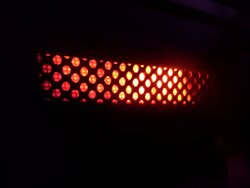BKVP, OUR SINCERE COMPLIMENTS.
When we arrive at this house typically on a Friday night and the house is cold. We keep the heat on 50'F when we aren't here. We need big heat when we get here and we need it pretty much now.
We fire up the Princess and within an hour, the fire in the stove is established, the house warming up nicely, and we're sitting down to dinner.
We are in shoulder season, we need heat but we don't need big heat.
Once this Princess is established, we can do just about anything we want with that thermostat. The stove responds pretty much immediately. We can turn the thermostat to low, and the stove burns on low it doesn't go out, it actually burns on low. We can turn the thermostat up and it responds. I turned it up this evening to cook dinner on the stove top (that works well too!) and then we turned it right back down. And down it went- but it didn't go out. Right now she's humming along at setting 1. Setting 1. Still lit, still burning, CAT active, but not running us out of here. I wouldn't have believed it if I hadn't seen it myself.
This is an AWESOME stove!






 )
)